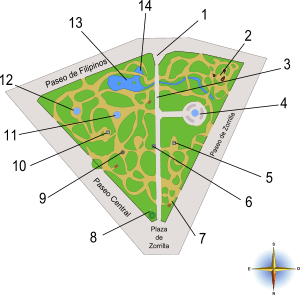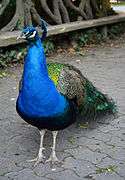Campo Grande (Valladolid)
Coordinates: 41°38′45″N 4°43′51″W / 41.64583°N 4.73083°W

2: Kids Games
3: Prince Paseo
4: Pergola with Fountain Swan.
5: Statue of Rosa chacel
6: Bust of Leopoldo Cano
7: Palomar
8: Floral shield of Valladolid and flag of Spain
9: Aviary
10: Statue of Miguel Iscar and Glorieta Book
11: Fountain of Fame
12: Faisanera and Fountain of the Frogs
13: Pond
14: Waterfall
The Campo Grande (English: "Large Field") is a large public park located in the heart of the city of Valladolid. Is triangular, has 115.000 m (11.5 ha) surface and is limited by the street Acera de Recoletos, the Paseo de los Filipinos and Paseo de Zorrilla.[1] Its main entrance is in the Plaza de Zorrilla, where together with a modern bill gate lies a floral shield of the city. The park is closed around its perimeter by a simple fence that runs between pillars, with doors on all sides.
Compared with the Retiro Park in Madrid is 10 size smaller (11'5 hectares compared to 118) and almost 30 size smaller than the Central Park in New York City (11'5 hectares compared to 341).
Its origin as a park or, more specifically, as a garden area, dates back to 1787, although from the fifteenth century must be regarded as an important urban space.[2] A notable feature of the park is the abundant bird population. Spread over the surface lies a Faisanera, an aviary and a loft belonging to Castilla Pigeon Club, which make the peacocks, pheasants and pigeons are very numerous and have become the real inhabitants of the park. It has a variety of trees that are a true botanical garden.
At various points in its history called Field of Truth and then Field of Mars but finally consolidated as Campo Grande.
Gallerie
 Panoramic view
Panoramic view
 Aviary
Aviary

References
| Wikimedia Commons has media related to Parque del Campo Grande. |
- ↑ Surface data of Asómate a Valladolid
- ↑ Duran Montero, María Antonia, La Alameda de los Descalzos Lima and its relationship with Hercules in Seville and Valladolid, Prado, Sevilla (Seville: Printing EEHA) [sn], 1984. Albardonedo Freire, Antonio, The urbanism of Sevilla during the reign of Philip II. Sevilla: Guadalquivir, 2002, p. 191-208